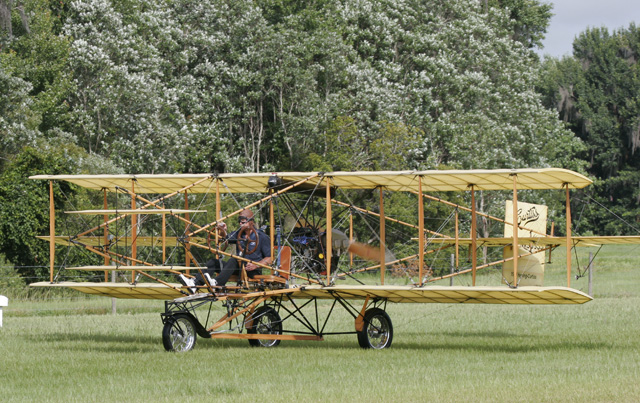
1909 Herring-Curtiss Pusher
A Pusher is “headed” when it has a horizontal flying surface in front of the pilot, known as a foreplane or a canard. The Herring-Curtiss Pusher has both a front and a tail canard.
Called a “pusher” because the engine and propeller are placed behind the pilot and, therefore, “push” the aircraft, the Curtiss Model D represent Early Flight pioneer Glenn Curtiss’s engineering philosophy: his aircraft would be an extension of the pilot who flies it.
At the time of the original aircraft’s production, the Wright Brothers held the patent on the then-state-of-the-art lateral control method known as wing-warping. Since the patent prohibited him from using this method, Curtiss went to the drawing board himself and emerged with a brand new innovation: the aileron, which proved to be a much superior method of controlling roll in flight, revolutionizing the construction of every airplane that followed it.
A Pusher is “headed” when it has a horizontal flying surface in front of the pilot, known as a foreplane or a canard. The Herring-Curtiss Pusher has both a front and a tail canard. The later “headless” version dispensed with the foreplane, as can be seen in the Pusher which hangs in the North Hangar.
This unique 2-seat version was originally built by Dean Wilson and Jim Otey in Idaho to celebrate the 100th anniversary of the first flight in that state. The centennial commemoration was successfully enacted, and the aircraft also drew attention at air shows. Considered by the EAA “an extraordinary replica … that conforms with the original design,” this aircraft features a few “product improvements to enhance the safety margins,” including a Continental O-200 A engine.
Specifications
- Year Built — 1909 (original); 2009 (reproduction)
- Wingspan — 38’3″
- Cruise Speed — 45 to 50 mph at 1900 rpm
- Gross Weight — 723 lbs (empty)
- Original Engine — 4 cylinder inline Roberts (40 hp)
- Current Engine — Continental O-200A (100 hp)
Kermit’s Comments
This Pusher is a great representation of an important historic type with some modern refinements, including a modern 100 hp engine, and is a fun aircraft in its own right. However, it also offers a great extra value as a trainer for the Benoist flyer we are constructing to commemorate the centennial of the first commercial passenger flight in 2014. The Curtiss Pusher is similar in type to the Benoist and is in the same speed range.